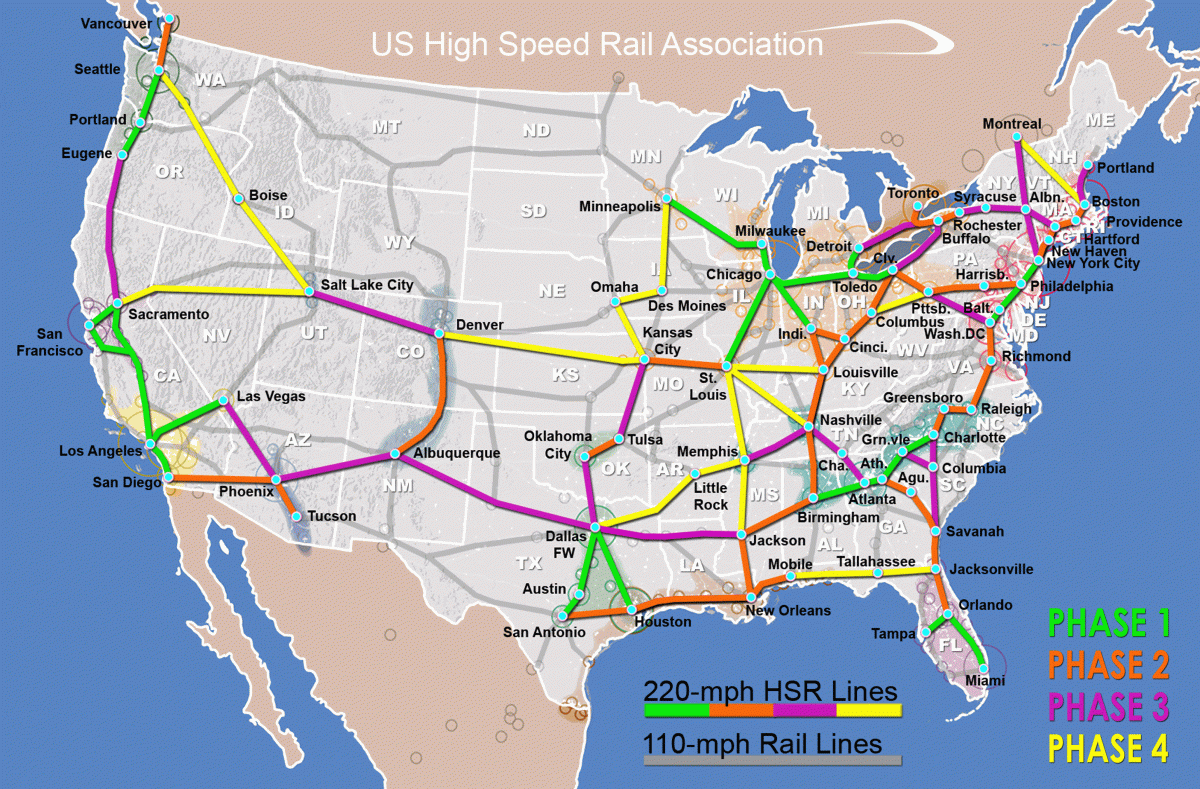The US High Speed Rail Association (USHSR) has published a map outlining its proposal for a new 17,000-mile high-speed rail network across the United States, which it says will ” cut our carbon footprint on a large scale.”
Under the plan, which the USHSR plans to build in four phases, it will be possible to travel between Seattle, Washington; San Diego, California; Miami, Florida; and Boston, Massachusetts, entirely on 220-mile-per-hour railroad tracks.
The past few years have seen a resurgence of interest in high-speed rail across the United States, after decades of little activity. There are many phones planned or under construction. Integrated high-speed networks already exist across Western Europe, Japan and China, which, according to Statista, had 25,000 miles of network by 2021.
The first phase of the new network proposed by the USHSR will see construction focused around seven locations, including lines connecting Dallas and San Antonio to Houston, Chicago to Minneapolis and Detroit, and New York City to Washington, DC.
This phase includes the completion of the California High-Speed Rail, a railroad currently under construction intended to run between San Francisco and Los Angeles. It also proposes a line connecting Las Vegas, Nevada, to Los Angeles, similar to the line currently under construction that will connect Las Vegas to southern California.

US High Speed Rail Association
Also included in this platform are plans to build a new high-speed rail connecting Houston and Dallas in Texas, which President Biden proposed in April but has not yet received full approval. Plans are moving forward on a high-speed rail link between Dallas and Fort Worth, though details remain unclear at this stage.
The second phase of the USHSR plan would extend the lines built in the first phase, and the northeast corridor would reach Boston and Charlotte, North Carolina. The Texas line would be extended east and north through New Orleans and Nashville, to connect with the network built in the first stage around Chicago.
Several other lines built in the first phase would also be expanded while new lines would be built connecting Denver and Albuquerque, Kansas City and St. Louis and Oklahoma City to Tulsa.
In the third phase, a line will be built connecting the existing network of California and the northwest from Eugene, Oregon, to Sacramento, while Las Vegas will be connected to Dallas and Jackson, Mississippi, by another rail. A new line between Salt Lake City, Utah, and Denver is also proposed at this stage, as well as extensions connecting the northeast network to Detroit and Montreal in Canada.
Finally, the fourth phase of the USHSR proposal will include new lines connecting Salt Lake City to the existing network through Seattle and Sacramento. Denver would be linked with Kansas City, Omaha, and Minneapolis, while Dallas would be linked with Memphis, St. Louis, and Louisville.
To talk to Newsweek about the plan, Andy Kunz, CEO of USHSR, said: “The Obama-Biden administration set a goal of giving 80 percent of Americans access to high-speed rail within 25 years. Access to like that across the country is still our goal.”
On its official website, the USHSR says the new network will “revive our economy, renew our manufacturing industry, create millions of jobs, end our dependence on oil, reduce congestion, create access to large areas of affordable housing, and reduce our carbon footprint in large parts.”
It continues: “Powered by electricity, this system provides a sustainable, affordable, safe way for everyone.”
USHSR was founded in 2009 as a non-profit organization to campaign for the construction of new high-speed rail networks across the US It works with trade associations, manufacturers and engineering firms to promote diversity of the government to support its projects.
Uncommon Knowledge
Newsweek aims to challenge conventional wisdom and find connections in search of common ground.
Newsweek aims to challenge conventional wisdom and find connections in search of common ground.
#highspeed #rail #map #showing #planned #routes
